YAMAHA JOG (CE50, CG50, CY50)
The Jog is one of Yamaha’s most popular scooters worldwide and it enjoyed a long run in North America from 1986 to 2001. Yamaha started producing the first generation of Jog in 1983, but this model didn’t make it to North American until 1986.
When the Jog did arrive in the USA and Canada, Yamaha considered it a member of their “Riva” family, so they often referred it as the Riva Jog in the 80’s and 90’s. The Riva prefix persisted until about 1999, after which this model was referred to as simply the Jog, as it had always been called elsewhere in the world.
In the early years, the Jog was Yamaha’s higher end 50cc offering, with the Razz (or Riva Razz) slotted in as the lowest priced 50. The Jog enjoyed a CVT transmission and a second mirror (!), which set it apart from the single speed Razz. During the later years of its run the Jog was unseated as Yamaha’s top 50cc offering by Yamaha’s sportier Zuma scooter.
 Generations
Generations
While Yamaha has sold countless versions and generations of the Jog worldwide, Canadians and Americans were sold three distinct generations. The first Jog (left in red) was the CE50 sold 1986-1987. This model was older when it introduced here, so it was soon replaced for 1988 by the CG50 (below in white). The CG50 generation of Jog used an all new frame and body design, but shared its vertical Minarelli engine with the departing CE50. Despite being an all new frame and body style, the CG50 Jog looks quite similar to the earlier CE50 so it’s easy to confuse the two. It didn’t help that they shared some components like rims and the same style of Jog logo.
A few ways to tell the difference are:
- The CE50 has three vent holes side vs. two holes in the CG50
- The CE50 uses skinny inverted forks, while the CG50 uses regular black telescoping forks like the newest CY50 Jog.
- The CE50 has a more pronounced kink where the front fender meets the body of the scooter
- The CE50 has 4 tiny vent slits above the front fender, while the CG50 had three larger ones
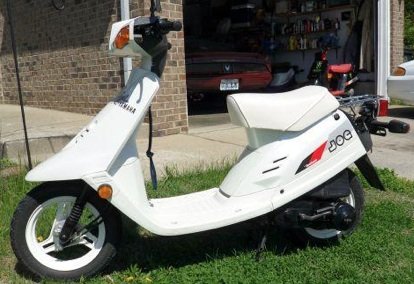
Motors
The CE50 and CG50 Jog’s sold from 1986 to 1991 used a vertical variant of Yamaha’s hugely popular 50cc Minarelli engine. This peppy engine was an air cooled 2-stroke that was restricted to 37mph in the CE50 Jog. Yamaha eased up the restrictions with the CG50, so stock top speed was 40mph for the second generation. When the CY50 Jog was introduced for 1992 it switched to using a horizontal version of the Minarelli engine. This motor was restricted to 43mph and capable of 45-48mph if de-restricted. The primary restriction in all of the Jog scooters is a gearing restriction (washer) in the variator, although the exhausts are quite restrictive as well.
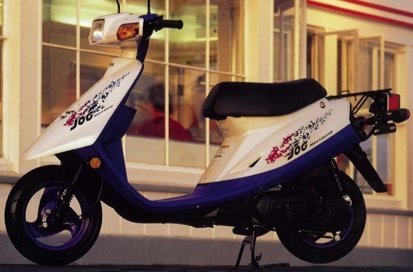
Yamaha also used the Minarelli engine in their popular Zuma / BWS scooter. The first generation of Zuma (CW50) used the same vertical motor as the CE50/CG50 Jog, while the second generation ZW50 Zuma (’02 – ’11) used the same horizontal Minarelli engine as the CY50.
Design
The early Jog scooters shared some parts in common with the Razz (ie. headlight, blinkers, taillight and mirrors) but mechanically they were quite different. The Jog had a proper CVT transmission and a higher top speed than the 30-35mph Razz. The early Jog’s also shared a few small with Yamaha’s Riva 50 scooter, such as the hand controls.
Globally Yamaha has produced some great versions of the Jog, but here in North American they’ve always sold the ‘rental fleet’ (base model) versions. That means drum brakes are used instead of a front disc brake and very little storage is present. The CE50 Jog’s sold in North America never had a glove box or underseat storage. Yamaha did revive their hardly useful ‘‘gear slot’ idea (also found on: CA50, CV80) with the CG50 generation, but there still wasn’t any enclosed and lockable storage on North America.
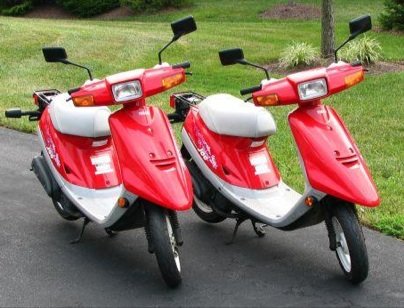
Discussion
During its era, the direct competition to the Jog was Honda’s 50cc Elite SR / LX in the USA and Dio in Canada (and the rest of the world). These competitors stack up pretty closely to the Jog in all areas except the Honda’s do have a glovebox. With all of these scooters you are dealing with similar styling, questionable color scheme offerings, little storage but powerful and very reliable engines. Other models available during the Jog’s era were Yamaha’s sporty/off-road inspired Zuma, Suzuki’s AE50 Hyper (Canada Only) and some of the lower end models (Razz, Elite E/ES) from Yamaha and Honda.
Besides the lack of storage, the Jog makes a great practical choice. You can find low milage examples for often really low prices ($500-$1200) and they usually last forever. The Jog is a great choice for anyone looking for cheap, peppy and reliable 2-stroke transportation.
Pros:
- Powerful & Reliable Minarelli engine
- Massive OEM and aftermarket parts availability
Cons:
- Very little storage
- Cheap brakes
- Strange color options
- Overseas versions will make you jealous
Links:
MotorscooterGuide Forums – Visit the forum on this site to chat about this scoot.
Jog Brochure Scans – Neat brochure and ad scans from the 80’s and 90’s
CG50 Service Manual – Very helpful for anyone who works on their own scooter.
CY50 Service Manual – Very helpful for anyone who works on their own scooter.
Maintenance Info – Maintenance tables from Jacks Scooter Shop
ScooterSwapShop – Aftermarket goodies
TheScooterReview – Nice CG50 Jog Review/Pics
Key Specs (CE50):
- Engine: 2-stroke, reed valve, 49cc vertical single
- Bore and Stroke: 40.0mm x 39.2mm
- Compression Ratio: 7.2:1
- Power: 4.5hp @ 7000 RPM, 4.3 lbs-ft torque @ 5500 RPM
- Lubrication: ‘Autolube’ oil injection
- Carb: Y12P
- Ignition: CDI
- Staring: Electric and Kick
- Fuel Tank: 2.9 litres / 0.75 gallons
- Oil Capacity: 0.8 litres / 0.2 gallons
- Length: 61.4” / 1560 mm
- Width: 24.2” / 615 mm
- Height: 37.5” / 953 mm
- Seat Height: 27.2” / 690 mm
- Wheelbase: 42.7” / 1085 mm
- Ground Clearance: 4.0” / 100mm
- Dry Weight: 123 lbs / 55.5 kg
- Suspension: Telescopic Fork (front), Unit Swingarm (rear)
- Brakes: Drum / Drum
- Tires: 2.75-10 4PR (Front and Rear)
Key Specs (CG50):
- Engine: 2-stroke, reed valve, 49cc vertical single
- Bore and Stroke: 40.0mm x 39.2mm
- Lubrication: ‘Autolube’ oil injection
- Ignition: CDI
- Starting: Electric and Kick
- Fuel Tank: 2.9L / 0.77 US Gallons
- Oil Capacity: 0.8L (0.84 US Qt)
- Length: 61.4” / 1560 mm
- Width: 24.4” / 620 mm
- Height: 38,3” / 972 mm
- Seat Height: 27.1” / 690 mm
- Wheelbase: 42.7” / 1085 mm
- Wet Weight: 129 lbs / 58.5 kg
- Front Suspension: Telescopic Fork, 44mm/1.73″ travel
- Rear Suspension: Unit Swingarm, Single Shock, 49mm/1.93″ travel
- Brakes: Drum / Drum
- Tires: 2.75-10 4PR (Front and Rear)
Key Specs (CY50):
- Engine: 2-stroke, reed valve, 49cc horizontal single
- Bore and Stroke: 40.0mm x 39.2mm
- Compression Ratio: 6.9:1
- Fuel Delivery: 14mm Teikei
- Lubrication: ‘Autolube’ oil injection
- Ignition: CDI
- Starting: Electric and Kick
- Fuel Tank: 3.5L / 0.92 US Gallons
- Oil Capacity: 0.8L / 0.84 US Qts
- Length: 64.8″ / 1645mm
- Width: 24.8″ / 630mm
- Height: 38.6” / 980 mm
- Seat Height: 28.0″ / 710 mm
- Wheelbase: 43.9” / 1115 mm
- Wet Weight: 143 lbs / 65 kg
- Front Suspension: Telescopic Fork, 42mm / 1.65″ travel
- Rear Suspension: Unit Swingarm, Single Shock, 42mm / 1.65″ travel
- Brakes: Drum / Drum
- Tires: 80/90-10 (Front and Rear)
- MSRP: $1799 (2001)
Colors:
- 1986: Stormy Red, Calm Yellow
- 1987: Stormy Red, Cosmic Blue
- 1988-1991: Silky White, Bluish Black, Mature Red
- 1992: Very Dark Blue Cocktail, Vivid Red Cocktail, Solid Fine Silver
- 1993: Very Dark Blue Cocktail, Vivid Red Cocktail, Solid Fine Silver
- 1994: Vivid Red Cocktail, Solid Fine Silver, Black, Deep Purple Solid
- 1995: Vivid Red Cocktail, Solid Fine Silver, Black, Deep Purple Solid
- 1996: Black, Deep Purple Solid, Silky White
- 1997: Black, Deep Purple Solid, Silky White
- 1998: Black, Deep Purple Solid, Silky White
- 1999: Black, Deep Purple Solid, Silky White
- 2000: Black, Silky White
- 2001: Black/Purple, Silky White/Purple

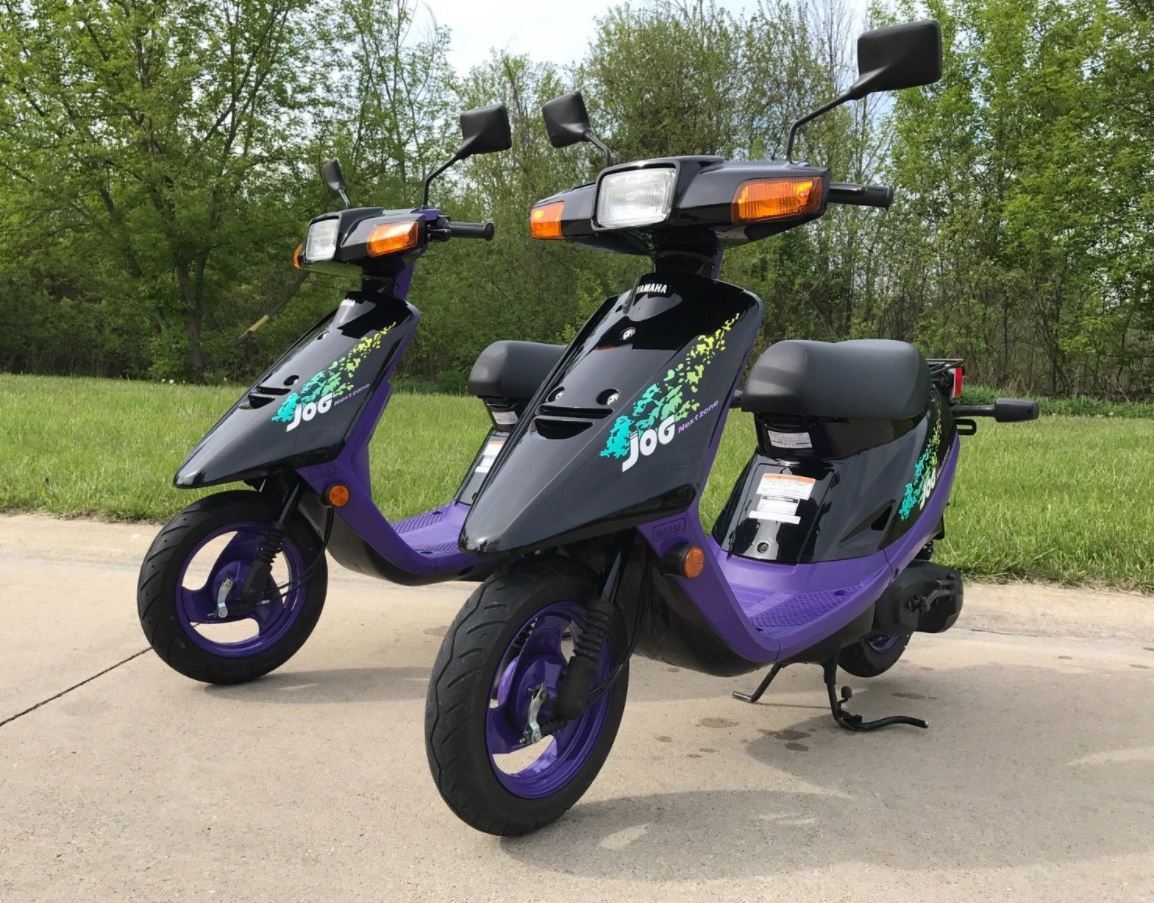
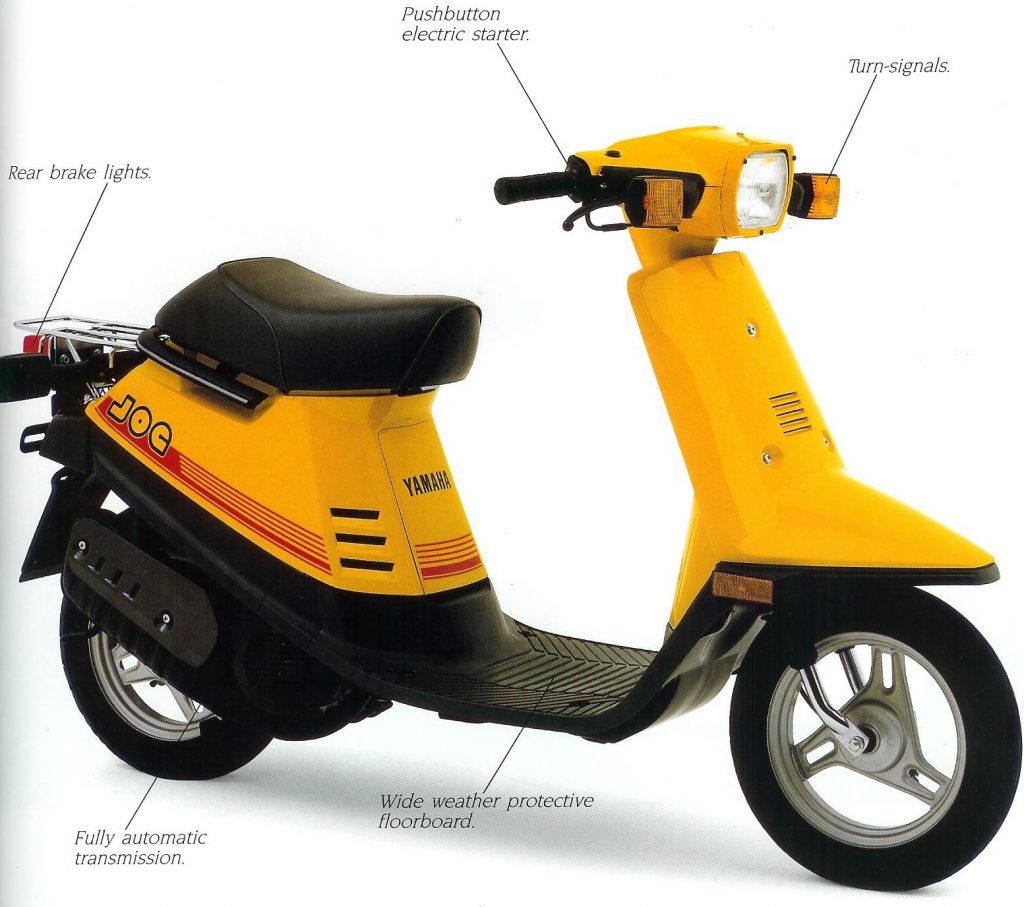
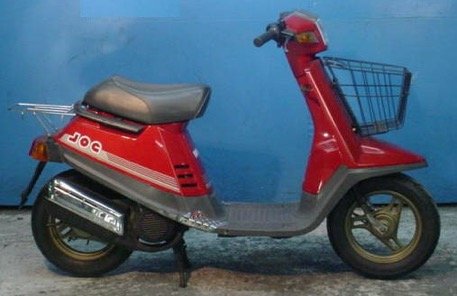 Generations
Generations